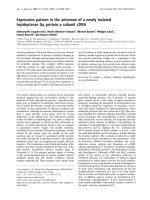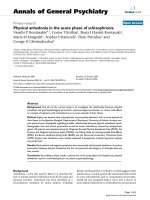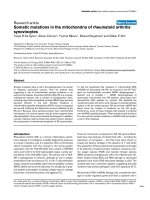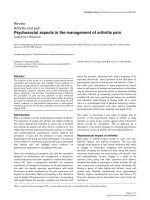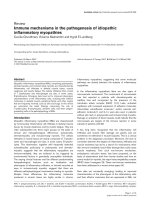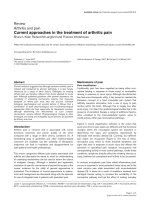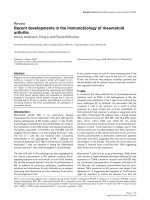Báo cáo y học: "Treating rhinitis in the older population: special considerations" pdf
Bạn đang xem bản rút gọn của tài liệu. Xem và tải ngay bản đầy đủ của tài liệu tại đây (171.49 KB, 4 trang )
BioMed Central
Page 1 of 4
(page number not for citation purposes)
Allergy, Asthma & Clinical
Immunology
Open Access
Review
Treating rhinitis in the older population: special considerations
Raymond G Slavin
Address: Department of Internal Medicine, Division of Immunobiology, Section of Allergy & Clinical Immunology, Saint Louis University School
of Medicine, 1402 South Grand Boulevard, M157, Saint Louis, MO 63104, USA
Email: Raymond G Slavin -
Abstract
Rhinitis in the elderly is a common but often neglected condition. Structural changes in the nose
associated with aging, predisposes the elderly to rhinitis. There are a number of specific factors that
affect medical treatment of the elderly including polypharmacy, cognitive dysfunction, changes in
body composition, impairment of liver and renal function and the cost of medications in the face of
limited resources. Rhinitis in the elderly can be placed in several categories and treatment should
be appropriate for each condition. The most important aim is to moisten the nasal mucosa since
the nose of the elderly is so dry. Great caution should be used in treatment with first generation
antihistamines and decongestants. Medications generally well tolerated by the elderly are second
generation antihistamines, intra-nasal anti-inflammatory agents, leukotriene modifiers and
iprapropium nasal spray.
Rhinitis is a common and bothersome condition in the
elderly. Despite its importance, little attention is paid in
the general medical literature. In the most recently pub-
lished highly regarded geriatric text, rhinitis is not
included in the index whereas rhinophyma is [1].
The number of Americans older than 65 years of age will
increase from 35 million to 86 million by the year 2050
[2]. While the exact number of elderly patient with rhinitis
is not known, it is believed that 40% of the general popu-
lation experiences nasal symptoms [3]. It would be safe to
say that the many changes that occur in the connective tis-
sue and vasculature of the nose predisposes aging individ-
uals to chronic rhinitis making the percentage of the
elderly with nasal symptoms significantly higher than the
general population [4].
The elderly have generalized decrease in body water con-
tent and, along with a degeneration of mucous-secreting
glands; the effectiveness of the mucociliary system is
reduced, resulting in symptoms of nasal stuffiness. In
addition, a decrease in nasal blood flow leads to atrophy
and drying of the nasal mucous membrane and increased
mucous viscosity. Structural changes in the nose with age
include atrophy of the collagen fibers and loss of elastic
fibers in the dermis. Weakening of the upper and lower
nasal cartilage, retraction of the nasal columella, and
downward rotation of the nasal tip contribute to an
increase in nasal airway resistance [3].
This article will deal with the special considerations of
treating rhinitis in the older population. Appendix 1 lists
the specific factors that may affect general medical treat-
ment in the elderly.
The elderly patient is frequently being treated for a variety
of medical conditions with a number of medications. The
more medications that are prescribed the less likely the
patient is to comply.
Published: 1 December 2009
Allergy, Asthma & Clinical Immunology 2009, 5:9 doi:10.1186/1710-1492-5-9
Received: 27 October 2009
Accepted: 1 December 2009
This article is available from: />© 2009 Slavin; licensee BioMed Central Ltd.
This is an Open Access article distributed under the terms of the Creative Commons Attribution License ( />),
which permits unrestricted use, distribution, and reproduction in any medium, provided the original work is properly cited.
Allergy, Asthma & Clinical Immunology 2009, 5:9 />Page 2 of 4
(page number not for citation purposes)
Aside from complying with directions for a large number
of medications, the elderly patient frequently has cogni-
tive dysfunction with a resultant decrease in memory.
A number of changes in body composition associated
with growing older may effect distribution of particular
medications. These changes include decrease in muscle
mass, fat and body water.
Medications metabolized through the liver and kidney
may be affected by decrease in function of the organ sys-
tems.
Finally, many elderly patients have limited financial
resources and may simply not be able to afford the cost of
the prescribed medications.
Types of rhinitis in the elderly
Appendix 2 shows the various categories of rhinitis in the
elderly. I will discuss each condition and the appropriate
therapeutic approach.
Before going into specific treatment options, I would like
to emphasize the main goal of treatment in most older
patients; namely moistening the nasal mucosa. The nose
of the elderly is dry for a number of reasons; a general
decrease in the body water content; degeneration of
mucous secreting glands, and a decrease in nasal blood
flow. Nasal lavage with isotonic sodium chloride is usu-
ally the preferred method to reduce the nasal dryness and
facilitate the clearing of thick mucous and crusts. Several
randomized controlled studies on saline nasal irrigation
suggest that it is a safe, effective, well-tolerated method to
be used in inflammatory diseases of the nose [5].
Allergic rhinitis
The incidence of allergic rhinitis decreases with age. The
peak incidence of 37 per 1000 occurs at 10 to 15 years of
age, with the incidence over 65 years of age being less than
3 per 1000 [6]. A significant decline in serum IgE levels
occurs with aging in atopic individuals with a tendency for
RAST and immediate-type skin test responses for selected
antigens and histamine to decrease [7]. While allergic
rhinitis is less common in the elderly, it should still be a
consideration.
Management
Antihistamines
Antihistamines are a mainstay in treatment of allergic
rhinitis. The first-generation or "older" antihistamines
(e.g., chlorpheniramine, diphenhydramine) are effective
in reducing sneezing, itching, and rhinorrhea. They have
untoward side effects, however, that are particularly nota-
ble in the elderly patient. The elderly eliminate both first-
and second-generation antihistamines more slowly [8].
The well-known side effects of the first-generation antihis-
tamines, sedation and decreased reaction time, are more
pronounced in the elderly. The anticholinergic effects are
drying of the mouth and eyes, blurred vision, urinary
retention, and constipation. These drugs should therefore
be used cautiously in older patients and should be
avoided in patients with symptomatic prostatic hypertro-
phy, bladder neck obstruction, and narrow angle glau-
coma.
The second-generation antihistamines (loratadine, ceti-
rizine, fexofendaine, desloratadine and levoceterizine) are
much better tolerated, with little or no sedative or anti-
cholinergic effects. Because they are metabolized more
slowly in the elderly, however, one should start with a
lower dose in this age group [9].
Decongestants
Decongestants are α-adrenergic agonists that reduce nasal
swelling, thus relieving congestion. The most commonly
used agent is pseudoepherine. Central nervous system
stimulation by these agents may result in anxiety, irritabil-
ity, insomnia, and palpitations. These drugs may aggra-
vate urinary retention in men and women with bladder
neck obstruction. They should be used cautiously in the
elderly and should be avoided in patients with poorly
controlled hypertension, coronary artery disease, cerebral
vascular disease, and bladder neck obstruction.
Anti-inflammatory nasal sprays
These agents may be useful in reducing sneezing, itching,
congestion, and rhinorrhea and are extremely safe in the
elderly. They can be divided into nonsteroidal agents (cro-
molyn, azelastine and olopatadine) and corticosteroids
(beclomethasone, flunisolide, triamcinolone, budeso-
nide, fluticasone and ciclesonide).
Leukotriene inhibitors
Montelukast has been approved in the United States for
use in the treatment of allergic rhinitis. Although there is
no study on the long-term therapeutic experience with
montelukast for use in the elderly, this drug is generally
safe and well tolerated. Other available leukotriene inhib-
itors include zafirlukast and zileuton.
Environmental control
Reducing exposure to allergens and irritants is an impor-
tant adjunct in treating patients with allergic and idio-
pathic rhinitis.
Immunotherapy
If environmental measures and appropriate medications
are not helping the patient with allergic rhinitis, immuno-
therapy (allergy injections) can be instituted; they have
been shown to be highly effective.
Allergy, Asthma & Clinical Immunology 2009, 5:9 />Page 3 of 4
(page number not for citation purposes)
Non-allergic (idiopathic, vasomotor)
Idiopathic rhinitis refers to inflammation of the nasal
mucous membrane unrelated to allergy, infection, struc-
tural lesions, or systemic disease. The term vasomotor rhin-
itis is frequently used, which implies that the cause in
known; this is not the case, however, and therefore the
preferred designation is idiopathic rhinitis [10].
The same approach to therapeutic management of allergic
rhinitis applies to idiopathic rhinitis. The FDA has
approved the use of intranasal azelastine for this condi-
tion.
Drug-induced rhinitis
Over 400 brand name drugs list rhinitis as a side effect.
The elderly patient is frequently being treated for a variety
of medical conditions with a number of medications that
can result in untoward effects of the nose. It is well known
the topical decongestants that downregulate α-adrenergic
receptors on nasal vasculature can cause rebound vasodi-
lation with overuse. Older patients are at particular risk
because of preexisting thinning and dryness of the nasal
mucosa.
A host of antihypertensive drugs, including central adren-
ergic blockers (clonidine), postganglionic adrenergic
blockers (guanethidine), β-adrenergic blockers (pro-
pranolol), α-adrenergic blockers (prazosin), vasodilators
(hydralazine), and diuretics (hydrochlorothiazide), may
cause nasal obstruction. Conjugated estrogens may also
increase nasal airway resistance.
Aspirin is a well-known trigger of bronchospasm in
patients with nasal polyps and asthma (Aspirin Exacer-
bated Respiratory Disease) but it can also cause severe
rhinitis in asthmatics with and without associated polyps.
The mechanism of aspirin is believed to be a cyclooxyge-
nase block that shifts arachidonic acid metabolism to the
lipoxygenase pathway, with leukotriene generation result-
ing in immediate nasal symptoms of rhinorrhea and
obstruction.
Psychotropic drugs and Viagra, drugs likely to be used by
the elderly, have also been shown to result in rhinitis.
Nonallergic rhinitis with eosinophilia (NARES)
NARES is characterized by eosinophil infiltration of nasal
tissue. Symptoms consist of perennial nasal congestion
and rhinorrhea. The response of intranasal corticosteroid
is generally excellent.
Gustatory rhinitis
This condition consists of profuse rhinorrhea elicited by
eating food, particularly highly seasoned foods. Cold air
may also be a trigger. Anticholinergic drugs may be useful
in reducing the rhinorrhea of gustatory rhinitis. Ipratro-
pium bromide is now available in nasal spray form
0.03%, which has no systemic absorption, and as such is
effective and safe.
Atrophic rhinitis
This condition of unknown cause is often seen in the eld-
erly. Atrophy and crusting of the nasal mucous membrane
occur with resorption of the underlying bone. The crust-
ing may result in an unpleasant odor called ozena [11].
Primary atrophic rhinitis may be caused on rare occasions
by organisms such as Klebsiella ozaenae. Secondary
atrophic rhinitis may result from nasal surgery, particu-
larly from turbinectomy performed for nasal congestion
or the previously used procedure for chronic rhinosinusi-
titis bilateral intranasal sphenoethmoidectomy [12].
Surgical treatment
Surgical reconstruction of the aging nose is aimed at
reconstituting support for the nasal upper lateral cartilage
and elevating the drooping nasal tip. Removal of tur-
binate mucosa should be avoided, especially when exces-
sive dryness is already a factor [5].
Septoplasty with or without inferior turbinate reduction
in patients 65 years or older with nasal septal deviation
may be beneficial in this population [13].
Appendix 1
Factors affecting medical treatment outcomes in the eld-
erly
• Polypharmacy and compliance
• Cognitive dysfunction and memory impairment
• Alterations in body composition (muscle, fat, water)
• Impaired hepatic and renal function
• Cost and limited resources
Appendix 2
Types of Rhinitis in the Elderly
• Allergic
• Non-allergic (idiopathic, vasomotor)
• Drug-induced
• NARES
• Gustatory
• Atrophic
Publish with BioMed Central and every
scientist can read your work free of charge
"BioMed Central will be the most significant development for
disseminating the results of biomedical research in our lifetime."
Sir Paul Nurse, Cancer Research UK
Your research papers will be:
available free of charge to the entire biomedical community
peer reviewed and published immediately upon acceptance
cited in PubMed and archived on PubMed Central
yours — you keep the copyright
Submit your manuscript here:
/>BioMedcentral
Allergy, Asthma & Clinical Immunology 2009, 5:9 />Page 4 of 4
(page number not for citation purposes)
Competing interests
The author declares that he has no competing interests.
References
1. Hazzard's Geriatric Medicine and Gerontology. 6th edition.
Edited by: Hatter JB, Aslander JG, Tinette, M, Studenski S, High KP,
Asthana S. New York. McGraw Hill; 2009.
2. Administration on Aging: Statistics on the aging population.
[Http://www.aaa.gov/prof/statistics/future_growth/PopAge2050.xls
].
Accessed November 5, 2005.
3. Sibbold B: Epidemiology of Allergy Rhinitis. In Epidemiology of
Clinical Allergy. Monographs in Allergy Edited by: Burr ML. Basel, Kargen;
1993:61-79.
4. Slavin RG: Diagnosis and treatment of rhinitis and sinusitis in
the elderly. Immunol and Allergy Clinics of N Amer 1997, 17:543-556.
5. Yimaz ASS, Corey JP: Rhinitis in the Elderly Current Allergy
and Asthma Reports. 2006, 6:125-131.
6. Pederson PA, Weeke ER: Allergic rhinitis in Danish general
practice: Prevalence and consultation rates. Allergy 1981,
36:375-381.
7. Styo RJ, Rittman-Johnson B, Walsh G: Aging and serum immu-
noglobulin E levels, immediate skin tests, RAST. J Allergy Clin
Immunol 1981, 68:421-426.
8. Simons KJ, Martin TW, Watson WTA, et al.: Pharmokinetics and
pharmocodynamics of terfenadine and chlorpheniramine in
the elderly. J Allergy Clin Immunol 1990, 84:540-597.
9. Kaliner MA: H
1
-antihistamines in the elderly. Clin Allergy Immunol
2002, 17:465-481.
10. Lund VJ, Aaronson D, Bousquet J, et al.: International consensus
report on the diagnosis and management of rhinitis. Allergy
1994, 49(Suppl):21-33.
11. Liston SL, Siegel LG: Nasal and sinus disorders in the elderly:
Which ones are life threatening? Geriatrics 1981, 36:91-97.
12. Moore GF, Freeman TJ, Agress FL, et al.: Extended follow-up of
total inferior turbinate resection for relief of chronic nasal
obstruction. Laryngoscope 1985, 95:1095-1104.
13. Busaba NY, Hossain M: Clinical outcomes of septoplasty and
inferior turbinate reduction in the geriatric veterans' popu-
lation. Amer J Rhinology 2004, 18:343-347.
